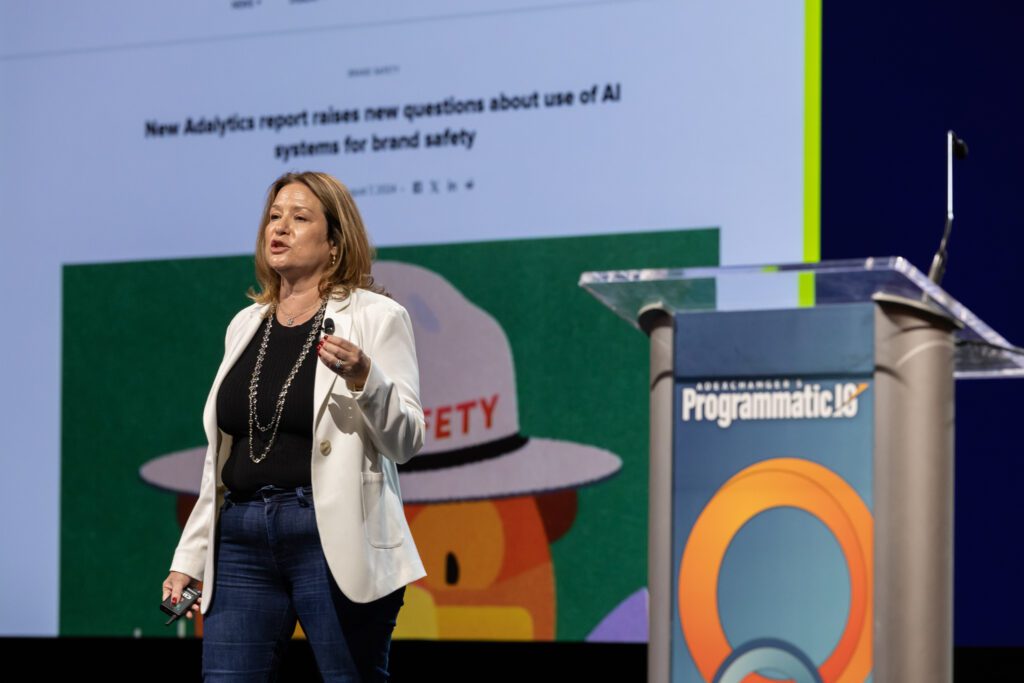Are advertisers afraid of the news?
Apparently so – especially during election season.
The vast majority – 83% – of US marketing executives have concerns about advertising their brands during elections, according to Madison and Wall’s 2024 Ad Spend Forecast.
That means brands are avoiding news coverage of this year’s presidential election, said Jana Meron, VP of revenue operations and data at The Washington Post, in a presentation at this week’s Programmatic I/O event in New York City. During certain periods this year, advertisers blocked more than 40% of WaPo’s inventory over brand safety concerns, she said.
As a result, brands are missing out on the highly valuable audiences that flock to political news during campaign season, she said.
Audience reach
Not only are brands costing themselves an opportunity to take advantage of news publishers’ increased reach during election cycles; they’re also missing out on performance boosts from some of the most highly engaged and high-value readers news outlets attract in any given year, Meron said.
The Washington Post boasts a political news audience of 10.9 million. More than half of these readers spend at least 3 minutes reading content on WaPo’s site per session, she said.
And 25% of Americans consider themselves news junkies who read seven news stories per day on average, according to Stagwell’s Future of News report published in May.
WaPo’s audience also spikes during times of increased attention on political news. For example, its site experienced a two-year high in ad impressions the day after the September 10 presidential debate between Donald Trump and Kamala Harris.
Ads targeted to political news audiences also appear to perform better than others.
Ads that appear on WaPo’s Politics and Opinions pages have 55% higher click-through rates than ads that appear elsewhere on the site, according to the publication’s internal campaign analytics.
WaPo’s politics readers also index highly for traits that correspond to what marketers consider high-value audiences, such as a high average household income, Meron said. Plus, 30% have some form of higher education, and they are 43% more likely to be retail investors, which is indicative of disposable wealth and financial acuity.
Fear of bad adjacencies
Given the benefits of advertising on political news, why do brands avoid it?
It’s all due to advertisers’ unfounded fears and double standards when it comes to news, Meron said.
It’s taken as gospel among most advertisers that placing an ad next to certain content can damage a brand’s reputation. PR nightmare stories about problematic adjacencies from the early days of contextual targeting, such as luggage ads appearing next to news coverage of plane crashes, have become cemented in the minds of marketers, Meron said.
“No brand wants to be the news,” she added.
But efforts to quantify the negative impacts of bad ad placements have never panned out, according to Meron. In fact, the research shows the opposite – that consumer spending is hardly impacted by ads appearing next to the news, she said.
To illustrate this point, Meron cited a survey released by YouGov.org in February that compiled the top five reasons why US consumers boycott brands. They included, in descending order: the brand’s products pose health risks; the company engages in unethical practices; the company does business with countries the consumer disapproves of; the brand acts against social causes the consumer agrees with; and the brand is polluting the environment.
“News is not on this list,” Meron said. “Advertising is not on this list. Advertising in news is not on this list.”
And yet brands avoid advertising in news to a greater degree than they avoid, say, engaging in unethical practices like unauthorized uses of consumer data or polluting the environment.
To be fair, consumers could perceive a brand supporting a news outlet whose coverage they don’t agree with as being on the opposite end of the increasingly widening political divide. And Meron agreed that the political divide is real and worse than ever.
But the data seems to support that, overall, consumers have positive views of brands that monetize news publishers. Among news consumers, specifically, 84% say advertising in trusted news outlets increases or maintains their trust in a brand, rather than negatively impacting it, according to the IAB’s 2020 News Trust Halo study.
Cutting through the noise
Ads appearing alongside divisive political content also has little effect on consumers’ purchase intent when compared to less controversial topics. Purchase intent for brands whose ads appeared alongside stories about Donald Trump, Joe Biden, the Oscars and the Super Bowl all hovered between 61% and 64%, according to Stagwell’s Future of News report.
Election season also presents brands with an underappreciated opportunity to stand out from the deluge of political advertising that floods news sites as elections approach, Meron said.
According to iSpot’s Impact of Political Advertising study, 43% of Americans find nonpolitical ads OK or even preferable during periods of heavy political advertising. And 37% said being served a large amount of political ads actually makes them pay more attention to nonpolitical ads.
“I’ve been in DC quite a bit lately,” Meron said, “and as I’m watching TV in my hotel room, I’m genuinely happy when an ad that isn’t a political ad shows up on the screen.”















